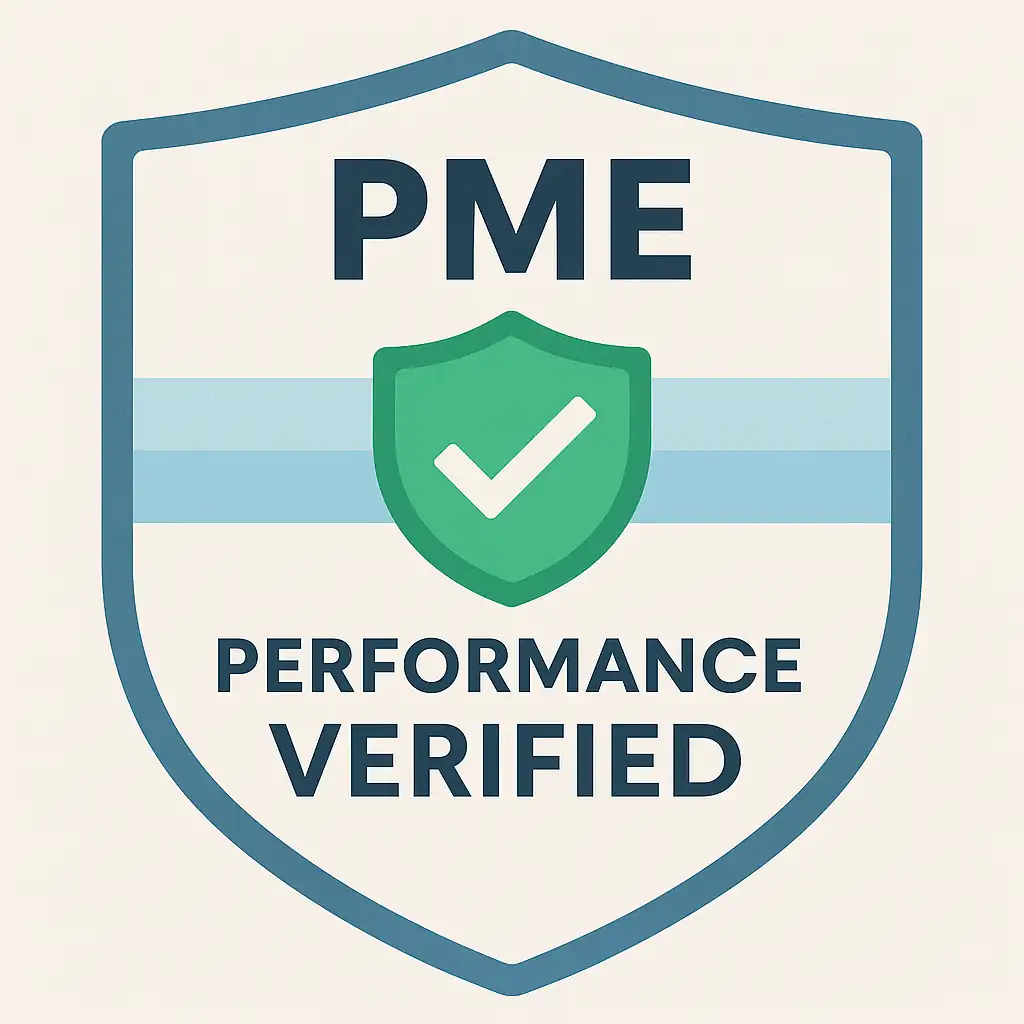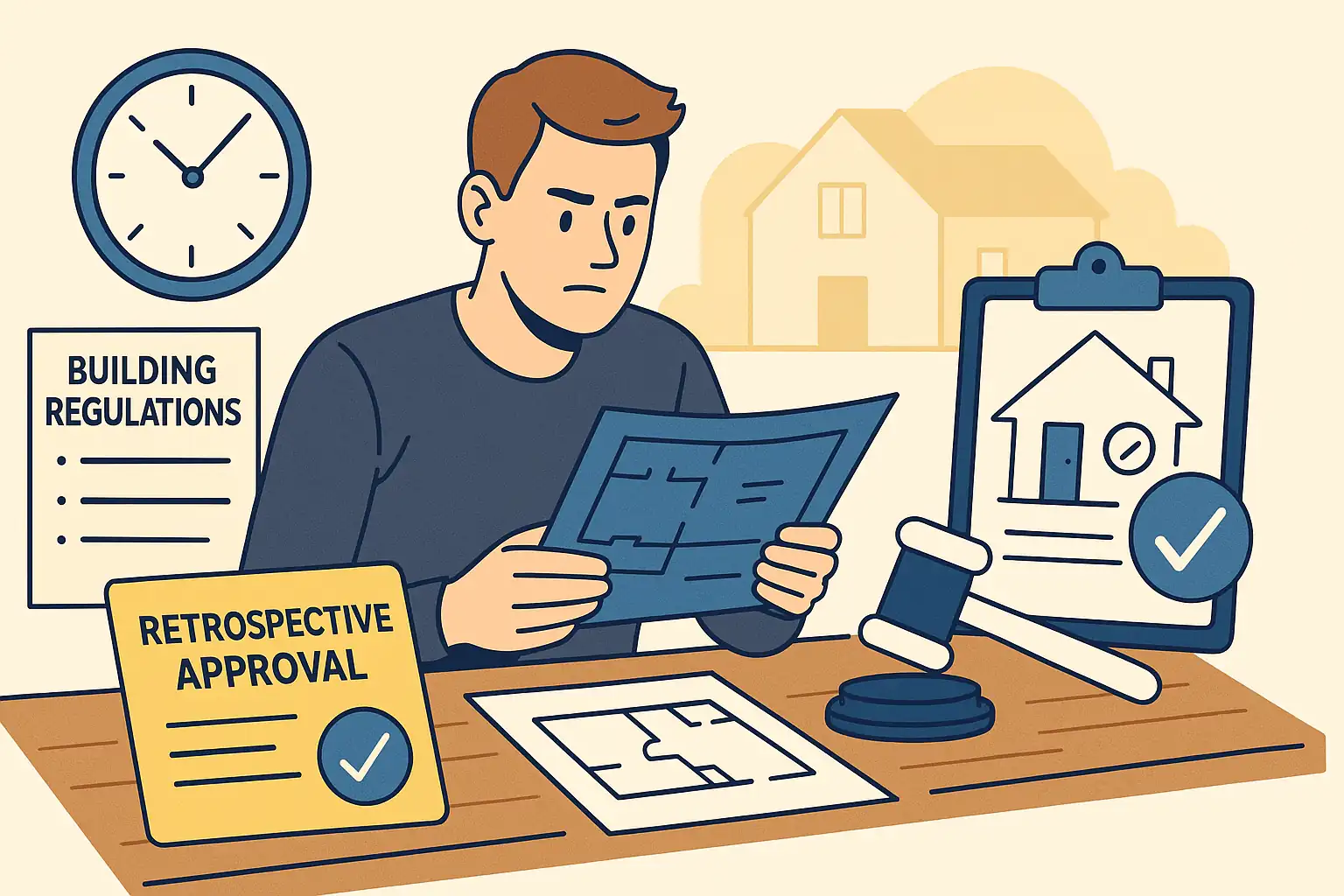Share this post:
Unsure if your past works can be signed off?
We’ll review what was built and advise the fastest legal route to compliance.
Short answer: There isn’t a simple “expiry date” for Building Regulations in the way many think. If works were carried out without approval, you can usually apply for retrospective approval via a Regularisation application. Councils focus on whether the finished work complies with the regulations in force at the time it was carried out — and they may ask for exposure (opening up) or remedial works to prove compliance. Mortgage lenders and buyers typically require evidence (certificate/letter) before a sale or refinance completes.
This guide covers the time factors that really matter (enforcement windows, lender expectations, council practice), what drawings and evidence to prepare, indicative costs and how to get signed off as efficiently as possible.
What “retrospective building regulations” actually means
“Retrospective building regulations” refers to applying after construction for Building Regulations approval on works that were undertaken without prior consent or notification. The formal route is called a Regularisation application, handled either by your Building Control team at the local authority or by an Approved Inspector (now “Registered Building Control Approver”).
Regularisation is common for older loft conversions, wall removals, extensions, garage conversions, garden rooms, and bathroom/kitchen alterations affecting structure, fire safety, drainage or electrics.
Is there a time limit for retrospective Building Regulations?
There isn’t a simple “you must apply within X years” rule for Building Regulations regularisation. Instead, what matters most are:
- Enforcement horizons: Local authorities hold powers to enforce non-compliant work. In practice, enforcement risk is often triggered by a transaction (sale/remortgage) or complaint, rather than a fixed expiry date.
- Lender & buyer requirements: Solicitors and lenders generally expect a completion certificate or equivalent evidence. Without it, sales and refinances can stall.
- Evidence of “date built”: Councils typically assess against the regulations in force when the work was carried out. You may be asked for proof (invoices, dated photos, planning records).
Because “time limit” queries are often about risk, think in terms of: will a buyer’s solicitor or lender accept what you have? If not, Regularisation is the usual remedy — regardless of how long ago the work was done.
Routes to get legal: Regularisation vs Full Plans
1) Regularisation (retrospective approval)
Used for finished works built without approval. The council may require opening up (e.g., exposing steels, joists, insulation, drainage runs) to confirm compliance. Remedial works may be requested before a certificate is issued.
2) Full Plans (prospective approval)
Used when you’re proposing new works and want detailed drawings checked first. See our guide to Building Control Inspections for what to expect as you build.
What councils will want to see in a retrospective application
- As-built drawings of the relevant areas (plans/sections/elevations).
- Structural info for altered elements (RSJs, lintels, trimmers) — calcs, steel sizes, bearing details.
- Fire safety measures — FD30 doors where needed, protected route, smoke/heat alarms, escape windows.
- Thermal elements — insulation build-ups for roof/walls/floors, U-values if upgraded.
- Drainage & ventilation — positions, gradients, connections, rodding access, extract fans/litres per sec.
- Electrical & gas safety evidence where relevant (e.g., certificates).
- Photographic evidence (if available), and any invoices/receipts that help to date the works.
For a deeper explainer of the process and paperwork, see Building Control — What It Is and our Certificates & Compliance Documents You Must Keep guide.
Costs & timelines (what to budget)
Step-by-step: how to get signed off fast
| Step | Action | Outcome |
|---|---|---|
| 1. Desktop review | We confirm if approval was required, what Parts are engaged (A, B, C, F, G, H, L etc.), and the best route. | Clear scope + route (Regularisation vs other). |
| 2. Survey & evidence | Measure up; gather photos, invoices, certificates; identify hidden items likely to need exposure. | As-built base pack ready. |
| 3. As-built drawings | Prepare plans/sections/elevations; mark structural/fire/drainage/thermal notes. | Council-ready information set. |
| 4. Submit Regularisation | Lodge application with drawings + evidence; request early site visit. | Case officer engaged. |
| 5. Opening-up | Expose steels/joists/insulation/drainage as requested; record photographic evidence. | Compliance proven or remedials identified. |
| 6. Remedials (if any) | Implement fixes (e.g., fire doors, guarding, insulation upgrades, drainage alterations). | Work brought up to standard. |
| 7. Certificate issued | Final inspection/approval; receive Regularisation certificate or letter of comfort. | Paperwork suitable for lenders/solicitors. |
Not sure if your idea fits Permitted Development?
We’ll check your project against PD rules and let you know if you need a full planning application.
Common pitfalls & “gotchas” to avoid
- Assuming a lender will accept indemnity insurance. Many won’t for building control issues because it doesn’t fix non-compliance.
- Skipping opening-up. If the council requests exposure and it’s refused, certification will usually stall.
- No fire strategy. Even small changes can disrupt safe escape. See Fire Safety – Part B for the fundamentals.
- Hidden drainage changes. Unseen alterations to traps/soil stacks/connections routinely trigger remedials.
Key technical checks councils focus on (typical)
Every case is unique, but officers commonly check:
- Structure (Part A): steel sizes/bearings, trimmer arrangements, padstones, load paths, differential movement.
- Fire (Part B): FD30 doors to habitable rooms off escape route, interlinked smoke/heat alarms, escape windows where applicable, protection to steel.
- Site prep & moisture (Parts C, D): damp proofing, ventilation of voids, resistance to contaminants.
- Ventilation (Part F): extract rates, cross-flow, purge ventilation, trickle vents where applicable.
- Drainage (Part H): gradients, rodding access, connections, backfall, proximity to sewers.
- Energy (Part L): insulation build-ups and continuity; thermal bridges around steels/openings.
Explore our deep-dives on Building Regulations and Building Control Inspections for more detail.
Related questions & comparisons people ask
- “How long does retrospective building regs approval take?” — depends on complexity and remedials; a few weeks to several months.
- “Time limit for retrospective planning permission?” — a separate process; planning has different enforcement windows.
- “Retrospective Building Regulations time limit London / GOV.UK?” — processes are similar nationally; fees/practice vary by council.
Local council quirks (incl. London & heritage)
While the regulations are national, practice varies:
- London boroughs: Often request more frequent inspections or higher specification details (especially on fire safety and flats/maisonettes).
- Heritage & conservation: In Conservation Areas or for Listed Buildings, expect closer scrutiny of alterations to structure, fire strategy and fabric. Planning consent may also be needed.
- Drainage sensitivity: Properties building over or near sewers can face additional checks or consents.
FAQs: Retrospective Building Regulations Time Limit
Is there a strict time limit to apply for retrospective building regulations?
No fixed “expiry” applies in the way many expect. The key is whether you can prove compliance (sometimes with opening-up) and whether lenders/solicitors will accept your paperwork at sale or refinance. Regularisation is the standard remedy.
How long does retrospective building regs approval take?
Straightforward cases can complete in weeks if evidence is solid and few remedials are required. Complex cases (uncertain structure/drainage, multiple openings-up) can take longer while works are checked and upgraded.
Can I get approval for works done many years ago?
Often yes, provided compliance can be proven (or achieved via remedials). You’ll likely need evidence of when the works were done and what was built.
Will indemnity insurance solve this instead?
Usually not for building control issues — many lenders won’t accept it because it doesn’t fix safety or compliance. A Regularisation certificate or letter of comfort is typically required.
What if my work also needed planning permission?
Planning and Building Regulations are separate. You may need a retrospective planning application as well. See our Planning Permission guide and local authority pages.
Does this apply to loft conversions and extensions?
Yes — these are common candidates for Regularisation. See our guides to Loft Conversions and House Extensions for context on typical checks.
Need a Regularisation plan pack?
We’ll prepare as-built drawings, coordinate structural info and manage council queries.
Next steps & useful guides
- Building Control — What It Is
- Building Control Inspections — What to Expect
- Building Notice vs Full Plans — Which Route is Best?
- Certificates & Compliance Documents You Must Keep
- Planning Permission Timelines (UK Guide)
- Fire Safety: Complete Homeowner’s Guide (Part B)
- Planning Permission — PME Pillar
External resources
Ready to move your project forward?
Plans Made Easy can prepare compliant plans, manage submissions, and guide you from idea to approval.

Performance Verified ✅
This page meets PME Optimisation Standards — achieving 95+ Desktop and 85+ Mobile PageSpeed benchmarks. Verified on


